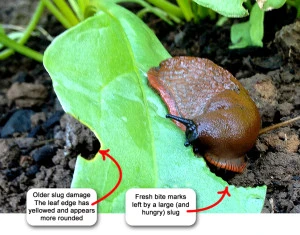
Hosta growers always seem to have their fair share (or Unfair) share of slugs. In my years in horticulture, I can’t really think of any other plant that gets “slugged” more than hostas, and last year seemed to be a big year for them!
 Slugs are related to snails. Like snails, they need a damp environment to survive. Remember how cool and wet last spring (2013) was? Bad for us, but heavenly for slugs- They thrived during a normal season. Slugs protect themselves from drying out by hiding during the day and feeding at night. The feeding damage appears on the leaves as large irregular holes, making your plants pretty unattractive. There are many different methods you may have heard or read about- suggesting control methods. But you’ve “tried them all”, and can’t seem to find one that truly works right?
Slugs are related to snails. Like snails, they need a damp environment to survive. Remember how cool and wet last spring (2013) was? Bad for us, but heavenly for slugs- They thrived during a normal season. Slugs protect themselves from drying out by hiding during the day and feeding at night. The feeding damage appears on the leaves as large irregular holes, making your plants pretty unattractive. There are many different methods you may have heard or read about- suggesting control methods. But you’ve “tried them all”, and can’t seem to find one that truly works right?
As more than just your typical landscape company, Beautiful Blooms and their team of trained and educated horticulturalists, has advanced in the green industry focusing on sustainability- therefore- chemical reliance is little to none. We suggest you start with the basics. themselves from drying out by hiding during the day and feeding at night.
 The first thing you do, is clean up your beds and areas around the damaged plants. Eliminate the daytime hiding places for slugs by removing leaf debris, along with things like bricks, boards, or other damp debris. Hand picking slugs off the plants (check around the bases) is also effective- If slimy creatures tend to give you the heebie-jeebies then we suggest wearing gloves.
The first thing you do, is clean up your beds and areas around the damaged plants. Eliminate the daytime hiding places for slugs by removing leaf debris, along with things like bricks, boards, or other damp debris. Hand picking slugs off the plants (check around the bases) is also effective- If slimy creatures tend to give you the heebie-jeebies then we suggest wearing gloves.
If you would like to try a couple of home remedies- Beer traps- partially bury a container (empty water bottle, yogurt cup, or jar) in the dirt- If you are using a container without a lid- make sure to build up some sort of “ramp” so they can crawl up to the top of the trap and inside. You can always cut access holes in the sides if you are using a plastic container that is taller in height.
Epsom salt, crushed eggshells or coffee grounds are sometimes used as a perimeter around desirable plants. Try turning over an empty flower pot or roll up wet newspaper. Place them nearby your plants, and leave them overnight. The slugs will head there to hide and you simply discard them in the morning. Some people swear that placing strips of copper tape around the hostas, act as a barrier, giving the slugs a tiny electrical shock- preventing them from crossing over to the plant.
If you are convinced that the only way to deal with the problem is a chemical pesticide for slugs, (called a Molluscicide), then the most commonly available products to control slugs, contain Metaldehyde, in liquid, granular, or pelleted bates.
If you are concerned about the safety of your neighbors, or loved ones- Sluggo slug and snail bait is a totally organic compound that actually breaks down into fertilizer (iron phosphate). It is not a toxic pesticide, and will not cause adverse effects when exposed near children, pets, and wildlife. But remember; always make sure to read the label, and follow application instructions.
If you feel like you need more info/advice- or have some questions for us regarding slugs, snails, or any other garden pest- Please feel free to contact us at any time. We are happy to educate our communities on the importance of maintaining a sustainable lawn/landscape. Remember, taking your 1st steps towards sustainability, is better than not taking any.


Comments (0)
Sorry! The comments have been closed.